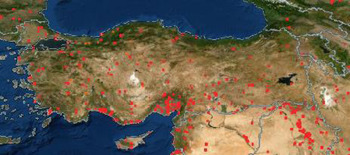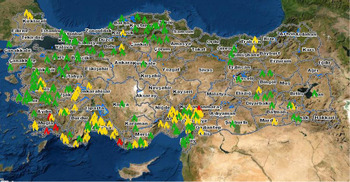With the intensification of climate change and human activities in recent years, large fires that have serious effects on ecosystems and human health are often occurring. Reference Guo, Zheng and Zeng1 Like many other countries in the world, Turkey has been struggling with a fire disaster since July 28, 2021. The Fire Information and Resource Management System, which the National Aeronautics and Space Administration (NASA) calls “FIRMS,” can monitor fires around the world using satellites. The image of the Turkey fire map dated August 4, 2021, from FIRMS, is seen in Figure 1 and it presents active fires. 2 State resources in Turkey are given in Figure 2. 3 Since the beginning of the fires, many citizens have shared information about the disaster area on social media, including a call for help and aid coordination. In recent years, in cases where communication systems are inadequate, especially during disaster periods, disease surveillance systems make more use of social media. Reference Aiello, Renson and Zivich4 Civil citizens and social media have been important in the fight against the ongoing fire disaster. We intended to reveal the information about fire aids and the most required materials with the opinions of the officials, volunteers, and victims in the disaster area.

Figure 1. NASA fire information for Resource Management System (FIRMS)—Turkey active fire map, August 4, 2021.

Figure 2. Fire map of Turkey as of August 5, 2021 (red: ongoing; yellow: under control; green: extinguished).
Method
Data were collected through interviews with the voluntary participation and consent of those in the fire disaster area. Revealing a current and ongoing phenomenon with the observations of the witnesses is suitable for the case study design.
Participants
The ages of the participants varied between 18 and 63 years, and participants totaling 15 consisted of 7 men and 8 women. Their professions included student, doctor, teacher, housewife, civil servant, academician, civil engineer, diving instructor, insurer, operator, and retired civil servant.
Findings
Information Resources
All of the participants stated that they felt great fear and anxiety with the start of the fires and that they did not know how to act at the beginning. The participants explained that they were informed about the fire disaster and the aid from their social media accounts. Those who lived and suffered in the region stated that they were also informed by the local administrations and the local press.
Views on Disaster Management Process
All of the participants stated that the most important problem during the fire disaster period was the lack of coordination and the uncertainty that came with it. The other primary problem mentioned was the lack of materials. The most needed materials of fireproof gloves, shoes, clothes, flashlights, charging equipment, burn ointments, and water were not available. Another problem mentioned is that volunteers felt unprepared due to the lack of information about disasters.
Opinions on Assistance to the Disaster Area
From the beginning of the fire disaster, civil citizens from every region of the country started to organize through social media to help the region. When asked about these aids, all participants stated that the food and material aids coming to the region were adequate and that the lists of supply requirements shared on social media were provided rapidly, but they also observed that there were problems with storage and distribution.
Views on the Influence of Social Media on the Disaster Relief Process
During disaster relief times, non-governmental organizations and local governments have shared information through social media, but individual users, including celebrities, phenomenal accounts, and various other users shared information about cooperation and those shares reached more in number. All of the participants stated that the social media shares made during the disaster time had a powerful effect in helping the civilian population deliver aid and get information quickly. Two participants explained that the social media posts were sometimes redundant, but the participants emphasized that the positive effect on aid was still high.
Discussion
The benefits and effects of social media on disasters are as follows Reference Dufty5 :
-
1. Reducing disaster risks: The aim here is to reduce the risks posed by the disaster. In this context, it may be possible (1) to raise awareness of the society concerning disaster risks, (2) to organize discussion platforms and to make plans in order to minimize the risks, (3) to manage and coordinate tasks, and (4) to transfer the experiences gained from the events, using social media tools.
-
2. Emergency management: The purpose of emergency management is to ensure the safety of the society in the face of a disaster or emergency. In this case, an emergency information system should be created using social media tools and crowdsourcing. It is also very important to issue emergency alerts to help people prepare for a disaster situation and to coordinate the community’s responses. Another important aim is to provide the coordination of post-event activities in order to ensure that learning takes place.
-
3. Establishment of social networks: The aim here is to create a social capital and knowledge regarding disasters. The establishment of social networks will enable the formation of supportive systems and the functioning of the leadership mechanism. With the information disseminated through social networks, support will be provided to the survivors during and after the disaster. These networks can also be used as a learning platform.
Recommendations
During the August 2021 forest fires in Turkey, social media seemed to be particularly influential in terms of the speed of extinguishing the fires, receiving supplies, and priority requirements. In this period, it can be said that social media helps build awareness about reducing disaster risks. Although there were many positive aspects and responses during the beginning of the fire disaster, the lack of education and adequate disaster preparedness resulted in a lack of fire disaster management and awareness. Considering these effects, the state administration and authorized disaster coordination units should use social media more effectively on the subject.






